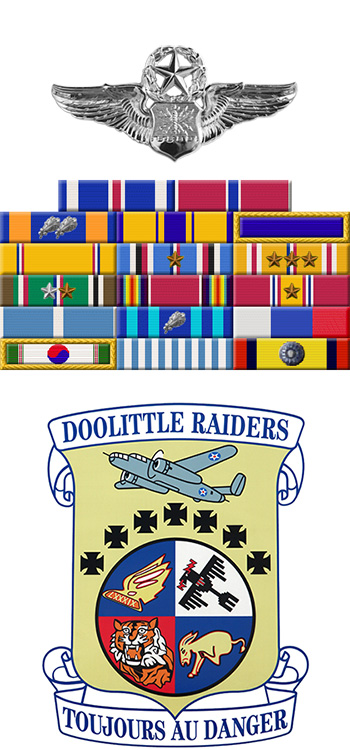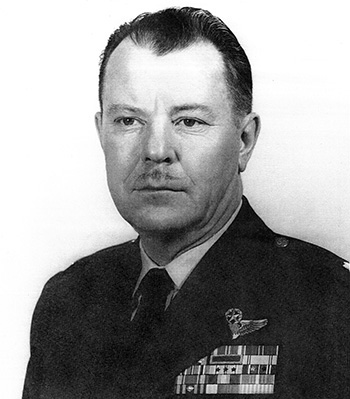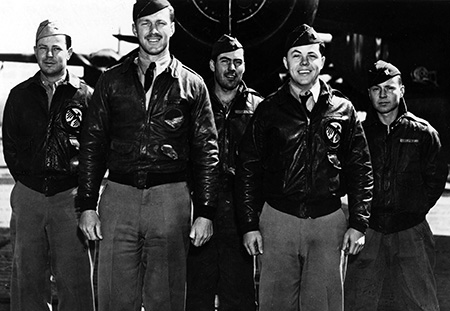
|
Frank A. Kappeler |
 |
|||
| Rank, Service | ||||
Lieutenant Colonel O-5, U.S. Air Force |
||||
| Veteran of: | ||||
|
||||
| Tribute: | ||||
Frank Kappeler was born on January 2, 1914, in San Francisco, California. He enlisted in the U.S. Naval Reserve on May 9, 1936, and served until his honorable discharge on May 8, 1938. He then enlisted in the Aviation Cadet Program of the U.S. Army Air Corps for pilot training on December 27, 1939, but did not complete the course and was discharged on February 5, 1940. Kappeler again enlisted in the Aviation Cadet Program of the Army Air Corps, this time for Navigator training, on November 6, 1940, and was commissioned a 2d Lt and awarded his navigator wings at Barksdale Field, Louisiana, on June 25, 1941. His first assignment was as a B-25 Mitchell navigator with the 89th Reconnaissance Squadron of the 17th Bomb Group at McChord Field, Washington, and at Pendleton Army Airfield, Oregon, from June 1941 until he was selected for the Doolittle Mission in February 1942. Lt Kappeler served as the navigator on the 11th B-25 to take off from the aircraft carrier USS Hornet (CV-8) on April 18, 1942, and after bombing targets around Tokyo, Japan, the crew flew to China and bailed out when their aircraft ran out of fuel. After the raid he remained in the China-Burma-India Theater until returning to the United States in August 1942. After serving in the United States, Capt Kappeler served as a B-26 Marauder navigator with the 454th Bomb Squadron of the 323rd Bomb Group in England and later in France from November 1943 to June 1945. Maj Kappeler served as an instructor navigator, as officer-in-charge of training aids, and on the Educational Advice Board with the 2622nd Base unit at Mather AFB, California, from September 1947 to October 1948, and during this time he attended Aviation Observer Bombardier training at Mather AFB from March to July 1948. His next assignment was as a B-29 Superfortress navigator-bombardier with the 328th Bomb Squadron at Castle AFB, California, from October 1948 to October 1950, followed by service as a KB-29 navigator with the 93rd Air Refueling Squadron at Castle AFB from October 1950 to September 1951. He served as Director of Plans with Headquarters Far East Air Forces supporting the Korean War in Japan from September 1951 to March 1952, and then served as a B-29 navigator and as Assistant Wing Observer with Headquarters 9th Bomb Wing at Travis AFB, California, and deployed to Guam, from March to October 1952. His next assignment was as an RB-36D Peacemaker navigator-bombardier with the 5th Strategic Reconnaissance Wing at Travis AFB from October 1952 to August 1953, followed by K-Systems Training at Mather AFB from August to September 1953. Maj Kappeler served as a B-36 navigator-bombardier with the 334th Bomb Squadron at Biggs AFB, Texas, from September 1953 to May 1955, and then as a B-36 and then B-52 Stratofortress navigator-bombardier and as Officer in Charge of the Reports and Analysis Branch with the 95th Bomb Wing at Biggs AFB from June 1955 to August 1961. Lt Col Kappeler served as a B-52 radar navigator with the 4136th Strategic Wing at Minot AFB, North Dakota, from August to September 1961, followed by service as Deputy Commander of Detachment 21, the Ballistic Systems Division Site Activation Task Force at Minot AFB from September 1961 to May 1964. His next assignment was as Special Assistant to the Commander of the 862nd Combat Support Group at Minot from May to August 1964, and then as Executive Officer of the 810th Strategic Aerospace Division at Minot from August 1964 until his retirement from the Air Force on March 1, 1966. Frank Kappeler died on June 23, 2010, and was buried at the Calvary Catholic Cemetery in Santa Rosa, California. |
||||
|
||||


